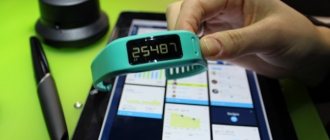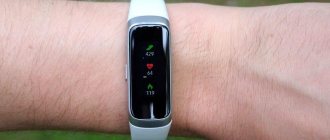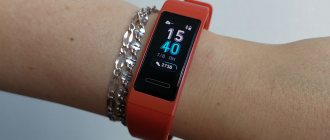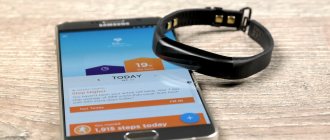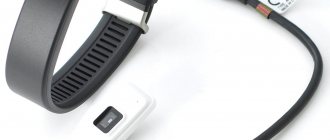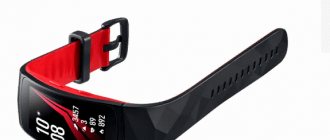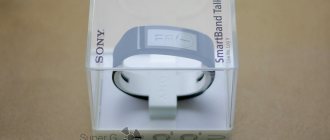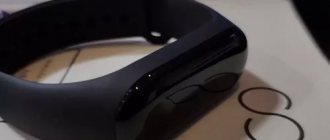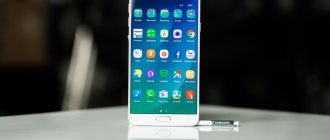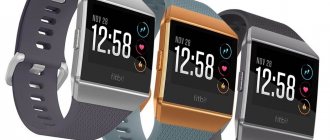In the modern market of gadgets for tracking activity, there are a large number of new and smart models. Garmin decided to release a device that not only made up for the shortcomings of the Vivosmart 3, but also became a worthy competitor to the Fitbit Charge 3. So, meet the new Garmin Vivosmart 4 smart bracelet, about the pros and cons of which you can read in my review.
Features of Garmin Vivosmart 4
| Material | Display: polycarbonate Frame: aluminum Strap: silicone |
| Display | Touch OLED 6.6 x 17.7 mm Resolution 48 x 128 pixels |
| Battery autonomy | 7 days |
| Memory | 7 scheduled events 14 days of activity tracking |
| Sensors | Heart rate sensor Barometric altimeter Accelerometer Light sensor Pulse Ox to measure blood oxygen |
| Connection | Bluetooth Smart and ANT+ |
| IP rating | 5 ATM |
| Smart features | Smart Notifications Text Messages Answer/Reject Call (Android Only) Weather Forecast Phone Music Control Find Phone / Find Bracelet VIRB Remote Control |
| Compatibility | Android, iOS |
| Dimensions and weight | Medium: 15 x 10.5 x 197 mm Fits wrists with a circumference of 122-188 mm Weight 20.4 g Large: 15 x 10.5 x 223 mm Fits wrists with a circumference of 148-215 mm Weight 21.5 g |
Design and display
Many people prefer to use fitness bands instead of smart watches, primarily because of the size. The Vivosmart 4 weighs only 20.4 grams and is very thin. This is a very important thing for a fitness tracker, as it allows you to constantly wear the device, thereby tracking more indicators. I don't think anyone wants to go to bed with a bulky device on their wrist.
The display on the Garmin Vivosmart 4 is very narrow. There are no problems navigating the interface, but selecting different options can be difficult and text is sometimes not completely visible, which is very annoying. I don't know if the problem is with the software or with the display, but this is a very big drawback. However, the image quality is good.
The new product is available in four color options: ripe berry color with a gold frame, gray with a rose gold frame, blue with a silver frame and black with white. Overall, the Vivosmart 4 is a great fitness tracker and its design is a big step forward for Garmin.
Fitness bracelet review
Vivosmart 4 differs from its predecessor in appearance and functionality. The device is aimed at women and will suit both a tracksuit and an evening dress.
The compact bracelet shows the time, monitors the state of the body and synchronizes with a smartphone. Comes with user manual.
Design and display
The latest models of devices have all the functions of a smart watch. Due to its compact size, users purchase a bracelet. The device weighs 20.4 grams. Its dimensions do not interfere with sleeping, working and playing sports.
The Garmin Vivosmart 4 display is narrow, but easy to operate. Problems may only arise with the display of text.
The new product is available in 4 color options:
- black and white;
- gray with rose gold frame;
- cherry blossom with gold border;
- blue with silver frame.
Autonomy Garmin Vivosmart 4
There is no data on battery capacity. assures that the tracker works for 7 days on a single charge. If you activate continuous heart rate monitoring and sleep tracking, the device will work without recharging for up to 4 days.
Smartwatch functionality
The fitness bracelet can:
- count the steps taken and regulate the daily norm;
- determine the distance traveled and analyze pedometer data;
- count calories burned;
- switch to sleep mode and track its phases;
- analyze activities;
- notify the user about the need for physical activity;
- look for a smartphone.
The tracker adjusts brightness and other functions. You can turn the Bluetooth module on and off from your phone. You can find a tracker from your phone if you use a proprietary program.
Fitness and health
The Garmin Vivosmart 4 tracks all the usual metrics: steps taken, altitude, intensity minutes, calories burned, stress, sleep and heart rate. However, due to the lack of built-in GPS and connection to your smartphone's navigation, the gadget cannot track distance or pace of movement. Even the Charge 3, the Vivosmart 4's closest competitor, comes with Fitbit Connected GPS for tethering to your phone.
The Vivosmart 4 bracelet is capable of tracking various sports profiles, including running, walking, strength training, swimming in the pool, yoga, etc. There is support for the Garmin Toe-to-Toe application. The tracker supports automatic recognition and recording of activity using Garmin Move IQ. All actions are displayed in the training calendar.
I tested the Garmin bracelet and compared the performance with other devices, including the Fenix 5, Fitbit Versa and Polar H10. All four gadgets have almost the same performance in the heart rate test (HR):
- Garmin Vivosmart 4: 179/157 (maximum/average).
- Polar H10: 175/161.
- Garmin Fenix 5: 170/155.
- Fitbit Versa: 181/156.
In another test, despite lacking GPS, the Vivosmart 4 was able to track distance data more accurately than the Versa. In the 6.7 km race, it clocked a distance of 7.4 km, while the Versa only managed 5.5 km. Steps taken, a key measure of activity, were also much more accurate on the Vivosmart 4 than Fitbit's competitor.
The updated Elevate heart rate sensor now alerts you if your heart rate is abnormal. It also tracks daily stress and displays the time you need to rest.
Garmin vivosmart HR fitness bracelet
Part 1: Band Design, Garmin Connect, Updated Mobile App, and Fitness Features
Garmin has a fairly large line of fitness devices - these include GPS sports watches, all kinds of accessories (heart rate monitors, etc.), and, of course, trackers. Among them are vivosmart bracelets. They are quite expensive compared to competing models, but they have advanced features aimed specifically at sports use. This winter, Garmin released a new vivosmart HR model. The letters H and R in the name mean heart rate, that is, heart rhythm. Pulse measurement is the main feature of the model.
Last year we told you about the Garmin vivosmart model. Its main feature was the presence of a small screen that displayed not only daily activity data, but also notifications from the smartphone and the time. From a design point of view, the model was very neutral and was positioned not as a fashion accessory, but as a device for exercise and constant wear. The bracelet was not afraid of immersion in water and dust, and was convenient for everyday use.
But the manufacturer did not stop there and decided to improve the device by equipping it with a heart rate sensor. At the same time, the software was also radically updated (the previous version of the Garmin Connect interface caused us a lot of complaints). We decided to figure out how successful the new product was and whether it makes sense for users of the first vivosmart to switch to it.
Let's look at the characteristics of the new product.
Garmin Vivosmart Specifications
- Screen: touch, OLED, 1 inch, 160×68
- Water protection: up to 5 atm
- Strap: Detachable (2 sizes available to choose from)
- Compatibility: devices running Android 4.x and later, iOS 8, computers running Windows and OS X
- Connection: Bluetooth 4.0 LE (to smartphone), cable (to computer)
- Sensors: accelerometer, altimeter, heart rate sensor
- Cameras, Internet: no
- Microphone, speaker: no
- Connectors: no
- Indication: screen, vibration signal
- Battery: up to 5 days of operation (capacity not reported)
- Weight: 30 g
For clarity, let's compare the characteristics of the bracelet with some of its competitors that we tested earlier.
| Garmin vivosmart HR | Garmin vivosmart | Sony SmartBand 2 SWR12 | Jawbone Up3 | |
| Screen | touch, OLED, 1″, 160×68 | touch, OLED, 1.36″, 128×16 | vibration signal, 3 LED indicators | vibration signal, 3 LED indicators |
| Water protection | 5 atm | 5 atm | yes (IP68) | splash water protection, standard not reported |
| Strap | removable, silicone | non-removable, silicone | removable, silicone | non-removable, thermopolyurethane |
| Camera | No | No | No | No |
| Sensors | accelerometer, altimeter, heart rate sensor | accelerometer | accelerometer, heart rate sensor | accelerometer, bioimpedance sensor, body temperature sensor, ambient temperature sensor |
| Microphone, speaker | No | No | No | No |
| Compatibility | Android 4.x and later devices / iOS 8 and later / Windows and OS X computers | Android 4.x and later devices / iOS 8 and later / Windows and OS X computers | Devices running iOS 8.2 / Android 4.4 and later | Devices running iOS 7 / Android 4.3 and later |
| Third party app support | yes (data transfer to them) | yes (data transfer to them) | there are extensions that allow you to control various smartphone applications from the bracelet (Android only), as well as transfer data to third-party applications | yes (data transfer to them) |
| Weight (g)* | 30 | 19 | 25 | 21 |
| average price | N/A | find out the price | find out the price | find out the price |
*according to manufacturer information
Judging by the comparison table, the screen of the new bracelet has become better, although its size has decreased. At the same time, water resistance has been preserved, but the weight has increased slightly. Well, most importantly, new sensors have appeared. Although Garmn vivosmart HR is still inferior to Jawbone Up3 in this parameter, but there, as we remember, the hardware capabilities were not used to 100%.
Other characteristics remained unchanged. Like its predecessor, the Garmin vivosmart HR has a big advantage in the form of compatibility with Windows and OS X. This means that it can be used without a smartphone at all (which may be important for conservative owners of push-button phones or smartphones on some less common OS - BlackBerry, Sailfish OS, Ubuntu Phone OS, Firefox OS, etc.).
Equipment
The Garmin Vivosmart HR bracelet is sold in a small cardboard box that doesn’t stand out in anything special.
Inside there is a rather modest package: the bracelet itself, a charging cable, a short instruction manual (including in Russian) and a booklet on safety precautions.
It is worth examining the cable more carefully. At one end there is a USB plug, and at the other there is a plastic platform with four contacts.
It attaches to the back surface of the bracelet, snapping into place with “ears” on the sides. This way, the bracelet is held securely while charging or synchronizing with a computer. And although this solution is less elegant than the currently fashionable inductive charging, it is relatively compact and not so expensive (although if you lose or break this cable, you will have to buy a new one, which, of course, is a minus).
Design
The appearance of the bracelet generally corresponds to the style of last year's model. It's still a fairly nondescript gadget, but the screen now stands out more than before. Now the bracelet does not have a monolithic silicone coating, but a noticeably prominent block with electronics, covered with a screen on top.
A button has appeared on the right, with which you can go to the main menu of the bracelet, as well as turn it on/off. The button practically does not protrude above the level of the bracelet, it is pressed moderately elastically, so that accidental presses are excluded.
On the back surface of the device we see a rather large protruding plastic block on which the heart rate sensor is located. The sensor is surrounded by three LED elements. When working, they glow quite brightly, and this can cause some inconvenience - for example, when you take off the bracelet, and they start to glow. Or the bracelet just lies on the table, and the LEDs glow.
Also note that the size of this unit is smaller than the Apple Watch and Mio Fuse, but larger than most other fitness bracelets and smartwatches. Theoretically, this should ensure greater accuracy of its operation. However, we will talk about this later.
The bracelet's strap is removable, but to detach it, you need to unscrew four screws. It's made of flexible silicone and has plenty of holes for fastening, so even users with thin arms won't have problems keeping it in place tightly (which is necessary for the heart rate sensor to work correctly). And for users with very large hands there is a larger bracelet. One way or another, the bracelet fits on the hand very comfortably.
In general, the design of the new product is not very different from the first Garmin vivosmart, with the only difference being that interacting with the screen is now more pleasant - the smooth plastic surface feels more familiar to the touch and is more responsive to touch. In addition, we think the appearance of a button is a plus.
Connection to smartphone and computer
To work with the bracelet, you need to install a mobile application or a program for a PC running Windows or OS X. In the Garmin vivosmart review, we noted that the ability to use the bracelet without a smartphone, but only with a PC, is a big plus of the model compared to many other fitness devices. bracelets. And we can only be glad that vivosmart HR retains this feature.
To get started, you need to connect the bracelet to your computer and download the Garmin Express application. We tested the bracelet with the OS X El Capitan operating system. After downloading and installing the app, you should see a message with your device name and serial number.
After clicking the “Add Device” button, you will be asked to log into your Garmin account (if you have used a Garmin vivosmart or any other Garmin fitness device, then you have one), confirm or change basic settings.
Next, you need to enter information about yourself: gender, height, weight, date of birth, time of falling asleep and waking up. The latter is necessary for the bracelet to correctly record your sleep.
After this, you can sync the data on the bracelet with the Garmin Connect online service. And here you can download the new firmware version, if available.
All further work with the device occurs through the Garmin Connect service. His appearance hasn't changed much from what we saw a year ago. As before, all information is presented in the form of cards, each of which corresponds to a specific menu item. And using the side menu, which opens by clicking on the “hamburger”, you can add or remove cards.
We described this service in detail in the article about Garmin vivosmart, so we won’t repeat ourselves and move directly to what has changed with the release of the new device.
Garmin Connect mobile app
While the web service interface has remained virtually unchanged, the mobile application has been updated much more seriously. And, I must say, the changes are for the better.
The main screen displays a brief summary of all types of activity. Two circles display the number of steps and duration of sleep per day. If you swipe from right to left, you will see details about the number of steps per day. You can click on the screen and all the detailed information will open. Same with the following screens.
It is important to note that the bracelet automatically determines your sleep time. Moreover, it is not at all necessary that this time fits into the time frame you specified in the settings. Let's say we indicated the sleep time from 3 to 11 o'clock, and in the screenshot above you can see that the bracelet recorded falling asleep at 2:37 (absolutely correct) and waking up at 11:32 (also correct). True, he did not recognize a couple of earlier awakenings, but this is quite acceptable.
If we look at the bottom panel of the application, we will see a row of icons there. Activity information screens are part of the first screen, “At-a-Glance” screens. The next Leaderboard icon is interesting for those who compare their achievements with other Garmin Connect users. The third icon - “Calendar” - opens a calendar, where the days when you wore the bracelet are marked, and your achievements are noted: received badges (that is, award badges), completing the norm for the number of steps, etc. The next item is “News Feed” - contains a list of our achievements by day (it is divided into two sections: “Activities” and “Steps”).
Finally, the last item “More” contains a long menu where you can customize many professional aspects and view detailed statistics. There is also a “Health Statistics” item here. It is there that we can, among other things, find information collected from the heart rate sensor. It is not clear why it was necessary to hide it so deeply. Apparently, they simply didn’t have time to fully optimize the application for the new Garmin vivosmart HR.
We will talk about how heart rate is determined and displayed in the second part of the article, but here let’s complete the review of the new interface of the Garmin Connect mobile application. So, in addition to the above, an interesting and important feature is the ability to synchronize with other applications: first of all, with Apple Health, but also with MyFitnessPal and Strava. What does it mean? That Garmin Connect can transmit data from the bracelet to these applications, and can also take from them the data that they send. For example, you have a smart scale that transmits data via Bluetooth to its application. It shares data with Apple Health. In turn, Apple Health sends this data to Garmin Connect, where you can see not only your activity, but also the dynamics of your weight (although, of course, the bracelet itself cannot provide you with such data).
However, there is a serious disadvantage here. For some unknown reason, Garmin Connect cannot transmit heart rate data to Apple Health. That is, the most valuable information from the bracelet is processed only by a proprietary application. Let's look at the screenshot below (left): we see that Garmin Connect can transmit data on distance traveled, number of steps and activity energy (apparently, this refers to calories burned). The screenshot on the right is an example of how data on the distance traveled is displayed (missed days are days when the author did not wear the bracelet). But there is no data on the pulse.
Another disadvantage we note is the inability to track swimming, and here it is no longer clear where the problem is - in the hardware (that is, in the bracelet itself) or in the software (Garmin Connect application). Although the bracelet has a high degree of moisture protection and you can swim in a pool or pond without worrying about its safety, and the Garmin Connect application has a separate card dedicated to swimming. And, for example, the Garmin Fenix 3 sports watch can upload information to it, but the Garmin vivosmart HR cannot.
Overall, the Garmin Connect mobile app interface has improved a lot, but it's still quite confusing and cluttered. For example, it is very difficult to find the option to set an alarm here. To do this, click on “More” and then click on “Settings”, then select vivosmart HR. The “Device Settings” page will open, and it will contain the “Alarm Clock” line. Try to guess!
At the same time, there is still no smart alarm function here, which is also a drawback - many cheaper fitness bracelets have this feature.
In the second part of the article, we will study in detail the function of measuring heart rate, as well as the interface of the bracelet itself and working with notifications.
Body Battery Function
New to the Garmin Vivosmart 4 is Body Battery, an innovative energy monitoring feature that allows users to see their energy levels, which should allow for better planning of workouts, rest times, etc. Throughout the day, depending on how active or relaxed you are, as well as many other factors, the indicator will increase or decrease.
Body Battery takes a few days to learn all your habits in more detail, so don't expect the metrics to be completely accurate initially.
Blood oxygen level
The Garmin Vivosmart 4 fitness band features a new built-in Pulse Ox sensor. This is pulse oximetry, a method of measuring oxygen levels in the blood based on several different factors, including overall health and fitness level.
Blood oxygen levels are below average and can cause shortness of breath and even show early signs of hypoxemia (low oxygen levels). The tracker can be manually configured to measure oxygen levels during sleep, or at any other time. However, the sensor can only monitor blood oxygen for a few hours, not all night.
First connection
Garmin Vivosmart HR connects via computer or smartphone. In the first case, you need to download and install the Garmin Express application (available for Windows and OS X) and connect the device via Bluetooth or ANT+. After this, you need to register with Garmin. All further manipulations are carried out on the website https://connect.garmin.com/ru-RU/.
To connect to your smartphone, you need to download the Garmin Connect app from Google Play, App Store or Windows Store. We recommend registering an account on the Garmin website in advance. When connecting for the first time, select Vivosmart HR from the list of available devices and begin filling out
personal information.
You must indicate your gender, height, weight, date of birth, activity level and sleep time. It is not clear why height and weight are given in feet and pounds, even if the application language is Russian. You have to use Google. Fortunately, after registration, you can change the measurement system to metric in the settings.
The daily number of steps depends on the choice of activity level. The time you fall asleep and wake up affects the automatic switching on and off of the silent mode on the bracelet.
Next, they ask you to select the types of activities you need that will be displayed in the application, as well as their order. You can quickly jump to short reviews in the corner of the application.
Smartwatch functions
The Garmin Vivosmart 4 has a standard set of smart features that let you check the weather, control your music, and use the Find My Phone feature. It can display all incoming notifications from your smartphone.
Android users can even reply to messages. However, reading messages on such a small screen is difficult, especially for people with low vision. But it's better than nothing.
Garmin app
The Garmin Connect app has a lot of sports and fitness tracking features, but it's not the most user-friendly fitness software. It lacks some of the things that Fitbit's app offers.
The Vivosmart 4 fitness tracker does not support third-party applications, which is disappointing. I would really like to see at least the likes of Endomondo, MayMyRun and RunKeeper supported in the future.
Fitbit Charge 3
- Screen size: 11.8mm x 22.7mm
- Screen type: OLED
- Waterproof: Yes, with swim support
- Replaceable strap: Yes
We would have liked it better if these trackers had color screens. But, in this case, autonomy would suffer. Both devices have the same battery life of up to 7 days.
Activity and health monitoring
Both bands have a variety of sports and fitness tracking features. Garmin Vivosmart 4 features a new Pulse OX sensor that measures blood oxygen saturation levels. This sensor can also be activated at night to better assess sleep quality. The Fenix 5 Plus watch was the first to receive such a sensor to determine blood oxygen saturation during climbs.
Fitbit Charge 3 can also measure your blood oxygen saturation levels and offers an advanced sleep monitoring system. Apparently, today Charge 3 can be considered the most accurate gadget for sleep analysis thanks to the introduction of improved algorithms. Thanks to the SpO2 sensor, the bracelet can identify interruptions in breathing during sleep, which may indicate problems such as allergies, asthma or sleep apnea.
Vivosmart 4 has one new and interesting feature - Body Battery. She knows how to determine the “energy reserves of the body” and suggests when it is better to go in for sports and when to rest. This tracker can also determine your stress level, count steps, distance and calories, and track various sports modes, including swimming.
With Move IQ, Vivosmart 4 automatically recognizes some of the most popular activities, such as running, walking or swimming. This bracelet does not have a GPS module, however, like the Fitbit Charge 3, so to obtain accurate data on speed, trajectory and distance, you will have to use the smartphone’s GPS.
Charge 3 supports SmartTrak technology, which automatically detects the most common activities. The bracelet also allows you to measure your heart rate and monitors women's health. One of the interesting features of the tracker is a training mode based on a goal (number of steps, a certain distance, number of calories). Vivosmart 4, as far as we know, does not have such a function.
Fitbit Charge 3 also has an auto-pause feature that automatically pauses workouts if the user suddenly stops, for example, while waiting for a traffic light to change during a workout. Fitbit can track more than 15 different modes.
Smart functions, water protection and autonomy
When it comes to smart features, both bracelets are almost identical. They can display weather information, receive call and text message notifications, and send quick replies or reject calls (Android phones only). The Garmin bracelet also supports finding your smartphone and controlling its music player, which the Charge 3 does, although it may get this feature with updates.
As mentioned above, both gadgets can withstand immersion under water up to 50 meters, and can track swimming. During the swim, only the duration of the swim can be seen on the tracker screen, and more detailed data about the swim will be available in the mobile application after the end of the swim.
Both devices can last up to 7 days on a single battery charge, but this will depend on the intensity of use.
Bottom line
The Garmin Vivosmart 4 is a great fitness tracker that gets the job done. It's perfect in almost every area except two. Lack of GPS option and connection to phone navigation. If you don't need GPS and the narrow display isn't an issue, the Vivosmart 4 is one of the best options.
Is it worth buying?
The screen size is the main thing that may deter users from purchasing this Garmin band. The screen here is small, which will be a problem for people with low vision. Nevertheless, I recommend Garmin vivosmart 4 for purchase, especially since $130 (8,500 rubles) is not a very high price for a gadget with a lot of functions. If you want a fitness tracker with built-in GPS, check out the Fitbit Charge 3.
Benefits of Garmin Vivosmart 4
- Thin and light.
- The display is better than the Vivosmart 3.
- Advanced sleep metrics.
- Determines how tired/energetic you are.
- Accurate heart rate sensor.
- Measures oxygen levels in the blood.
- Withstands pressure under water up to 5 ATM.
- The Connect app has many features.
Disadvantages of Vivosmart 4
- There is no GPS or connection to the phone's GPS.
- The narrow display is difficult to use.
- The heart rate sensor sometimes turns itself off.
Appearance
Garmin Vivosmart HR looks discreet, but at the same time elegant and minimalistic. The blue bracelet is equally suitable for both men and women. The design is a capsule, on the sides of which there are inserts made of hard plastic, smoothly turning into a strap, due to which the bracelet fits tightly to the wrist.
The strap is made of soft hypoallergenic rubber with a strap tail lock in the form of a rubber ring.
On the front side of the bracelet there is a monochrome display. Its dimensions (25.3×10.7 mm) and resolution (160×68 pixels) are sufficient for comfortable reading of information even from an arm's length distance. The screen is transflective. In other words, like an ordinary book: the brighter the light falls on it, the better the text is visible. This makes the Vivosmart HR great for outdoor activities.
If there is not enough light, you can turn on the backlight. To do this, you either need to press the screen or turn your wrist towards you. Compared to the Huawei Watch, this feature works better and works 95% of the time. Turning it back turns off the backlight. Brightness can be adjusted in settings. In addition, the screen is touch-sensitive, and reacts not only to the touch of fingers, but also to any objects. The bracelet can be operated without removing the gloves. The display is covered with a plastic panel on which your finger glides perfectly. It feels as if a grease-repellent layer was applied on top: fingerprints do not remain on the panel, and water stains are easily erased.
Vivosmart HR can withstand pressure up to 5 atm. Without removing the bracelet, you can safely wash your hands, shower and swim.
A physical key has appeared to the right of the display, which opens an additional menu. More on him later. For now, let's move on to the back of the bracelet. The capsule is screwed to the strap with four screws. Access to them is open, if desired, you can unscrew them, but why? Nearby there is a connector for the charger and a plate with the serial number.
The heart rate monitor is located in the middle. It consists of three emitting LEDs and one capturing sensor. The principle of operation is the same as in fitness trackers and smart watches: light from the diodes hits the capillaries inside the wrist, is reflected from them, and then the sensor reads the speed of its return. To reduce error, the Vivosmart HR should fit snugly into your hand, so the heart rate monitor protrudes slightly above the surface. This does not affect the comfort of wearing and does not cause discomfort.
